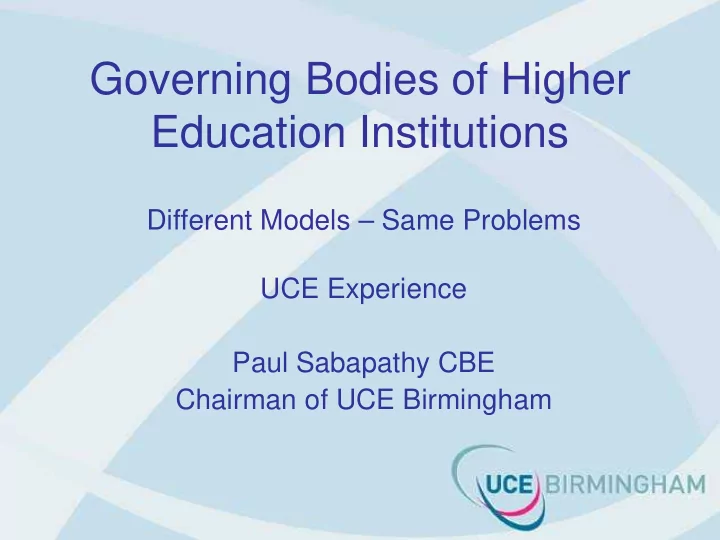

Governing Bodies of Higher Education Institutions Different Models – Same Problems UCE Experience Paul Sabapathy CBE Chairman of UCE Birmingham
Contents • Introduction • CUC Code – Role of Governing Body • English Governance Model • Post 1992 Model of Governance • UCE Background • Governance Challenges Facing HEI’s – UCE Approach • Conclusion
Introduction (1) • Bologna, Paris and Oxford Universities have been around for over 600 years, and are successful. So why are we talking about Governance in Higher Education today? • It is because organisations need to continually improve, otherwise they atrophy .
Introduction (2) Advice given by Sheikh Mohammed, ruler of Dubai, recently on the BBC. • Every morning on the African plain, a gazelle wakes up. It knows that it must outrun the fastest lioness if it is not to be killed. • Every morning on the African plain, a lioness wakes up. It knows that to eat that day it must outrun the slowest gazelle or it will starve. • It does not matter if you are a gazelle or a lioness, when the sun comes up you better be running.
CUC Code – Role of Governing Body (CUC Governance Code of Practice, November 2004) • Every HEI shall be headed by an effective Governing Body, which is unambiguously and collectively responsible for overseeing the institution's activities, determining its future direction and fostering an environment in which the institutional mission is achieved and the potential of all learners is maximised. • The Governing Body shall ensure compliance with the statutes, ordinances and provisions regulating the institution and its framework of governance and subject to these shall take all final decisions on matters of fundamental concern to the institution.
English Governance Model Main Features • 131 English HEIs • Diverse - size, mission, subject mix • Only Universities award research degrees • Self-governing, independent • Higher Education Funding Council (HEFCE) – buffer between HEIs and Government • £3,000 student fees from 2006
English Governance Model Three main models of Governance structure based on one governing body: • Ancients – Oxford and Cambridge founded over 500 years ago. Vice Chancellor is head of governing body. Power with the colleges. Attempting to restructure. Pre 1992 – Founded in 19 th century, generally incorporated by • Royal Charter giving degree-awarding powers. Some by Act of Parliament. • Post 1992 – Set up by Act of Parliament, gave power to Privy Council acting on behalf of the monarch to grant title of university to polytechnics and colleges that met the criteria. Act specified Governance Structure.
Post 1992 Model of Governance Formal Responsibilities under Education Reform Act 1988 The Articles require the University to have a Board of Governors and a Senate, each with clearly defined functions and responsibilities, to oversee and manage its activities. The Board of Governors shall be responsible for: • The determination of the educational character and mission of the University and for oversight of its activities. • The effective and efficient use of resources, the solvency of the University and the Corporation and for safeguarding their assets.
UCE Background (1) • History. • Mission: Providing a high quality Teaching and Learning Experience to our diverse range of students. Engaging and working with our local communities and partners to improve the social, cultural and economic well being. Engaging actively in consultancy and research to benefit a number of groups. • Seven Faculties located on eight sites. • Student Numbers.
UCE Background (2) • Financial Position: Income Surplus Operating Cash Capital Investment • UK League Table. • External Audit. • Board Membership.
Governance Challenges Facing HEIs UCE Approach (1) • Tension between increasing student numbers and maintaining quality. • Academic freedom versus Corporatism. • Increased competition for students. Internationalisation of Higher Education . •
Governance Challenges Facing HEIs UCE Approach (2) • External regulation. • Research specialisation. • Need for committed and skilled Independent Governors who can support and challenge HEI Management. • Competing demands and paucity of resources.
Conclusion (1) • Agree, although we have different governance structures all HEIs face similar challenges. • Governance approaches taken will vary according to: Institutional mission and values Institutional history and culture Government policy Other stakeholder needs • Good governance does not guarantee success.
Conclusion (2) • ‘The real challenge for directors isn’t regulatory compliance – it’s high performance. To achieve it, they need to systematically examine their purpose, tasks, talents, information, and agenda’. David A Nadler, ‘Building Better Boards’, Harvard Business Review, May 2004.
Recommend
More recommend